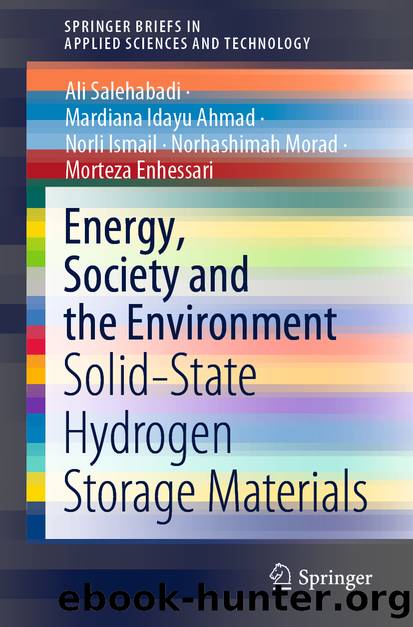Energy, Society and the Environment by Ali Salehabadi & Mardiana Idayu Ahmad & Norli Ismail & Norhashimah Morad & Morteza Enhessari

Author:Ali Salehabadi & Mardiana Idayu Ahmad & Norli Ismail & Norhashimah Morad & Morteza Enhessari
Language: eng
Format: epub
ISBN: 9789811549069
Publisher: Springer Singapore
4.4 Carbon-Based Materials
Reviews drawn from literature help us to draw a conclusion that the carbon materials are the best solid-state host for hydrogen storage (Alicia et al. 2017; Liu et al. 2011; Zhang et al. 2014a, b; Zhou et al. 2017). Carbon materials are a large group of nano-/microporous materials proposed for hydrogen storage owing to their high specific surface area. Activated carbons (ACs), carbon nanotubes (CNTs), multiwall carbon nanotubes (MWCNTs), graphene (GO), fullerene (F), and carbon dots (CDs) (Schlapbach and Züttel 2001). These materials can be subjected to the reversible hydrogen sorption according to the Langmuir isotherm model (Broom and Webb 2017). The wide range application of these materials has been restricted due to the low adsorption capacity at high cryogenic and low pressure (Froudakis 2011). Figure 4.6 shows an overall view of the process of hydrogen storage in carbonaceous materials.
Fig. 4.6Hydrogen storage carbonaceous materials
Download
This site does not store any files on its server. We only index and link to content provided by other sites. Please contact the content providers to delete copyright contents if any and email us, we'll remove relevant links or contents immediately.
| Concrete | Extraction & Processing |
| Fracture Mechanics | Materials Science |
| Metallurgy | Polymers & Textiles |
| Strength of Materials | Testing |
Whiskies Galore by Ian Buxton(41875)
Introduction to Aircraft Design (Cambridge Aerospace Series) by John P. Fielding(33064)
Small Unmanned Fixed-wing Aircraft Design by Andrew J. Keane Andras Sobester James P. Scanlan & András Sóbester & James P. Scanlan(32743)
Craft Beer for the Homebrewer by Michael Agnew(18140)
Turbulence by E. J. Noyes(7935)
The Complete Stick Figure Physics Tutorials by Allen Sarah(7307)
Kaplan MCAT General Chemistry Review by Kaplan(6866)
The Thirst by Nesbo Jo(6826)
Bad Blood by John Carreyrou(6546)
Modelling of Convective Heat and Mass Transfer in Rotating Flows by Igor V. Shevchuk(6391)
Learning SQL by Alan Beaulieu(6209)
Weapons of Math Destruction by Cathy O'Neil(6142)
Man-made Catastrophes and Risk Information Concealment by Dmitry Chernov & Didier Sornette(5921)
Digital Minimalism by Cal Newport;(5662)
Life 3.0: Being Human in the Age of Artificial Intelligence by Tegmark Max(5474)
iGen by Jean M. Twenge(5366)
Secrets of Antigravity Propulsion: Tesla, UFOs, and Classified Aerospace Technology by Ph.D. Paul A. Laviolette(5309)
Design of Trajectory Optimization Approach for Space Maneuver Vehicle Skip Entry Problems by Runqi Chai & Al Savvaris & Antonios Tsourdos & Senchun Chai(5011)
Pale Blue Dot by Carl Sagan(4909)
